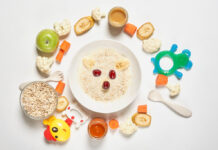If you’re looking for easy stage 2 baby food recipes, you’ve come to the right place. There are plenty of delicious and nutritious recipes for stage 2 baby food that you can make at home. From stage 2 baby food recipes with meat, like chicken and beef, to recipes featuring a variety of vegetables, there’s something for every baby’s taste buds. Incorporating meats such as chicken into your baby’s diet can provide a good source of protein, while vegetables can introduce a variety of essential vitamins and minerals.
It can also be a fun and rewarding experience. As your little one graduate from purees and moves onto more textured foods, it’s important to provide a well-rounded diet that includes a variety of flavors and nutrients. In this stage, introducing meats and vegetables can provide a diverse and balanced diet for your baby’s growing needs. This is where stage 2 baby food comes in.
In this article, we’ll explore some of the best stage 2 baby food recipes to help you provide your little one with a healthy and enjoyable eating experience. These recipes are designed to make the transition to solid foods as smooth and enjoyable as possible, ensuring your little one receives the nutrition they need to thrive.
What is stage 2 baby food?
As your little one keeps growing, their eating needs change too. Say hello to stage 2 baby food – a special time when new textures and yummy flavors come into play. Let’s explore what this stage means, the best age to start, and how to know when your baby is all set to try these tasty new things.
Defining Stage 2 Baby Food
Stage 2 baby foods are generally recommended for babies between 6 and 9 months old who have started to eat solid foods. These foods are slightly thicker and chunkier than stage 1 baby foods and contain a combination of fruits, vegetables, grains, and meats to provide a more varied and balanced diet for the growing baby.
Readiness Indicators
Wondering if your baby is ready for stage 2 baby food? Look for these signs that can help you know:
- Strong Head and Neck Control: Your baby can hold their head up nicely and sit with a little help. This is important to eat safely and not have any problems.
- Interest in Food: If your baby seems curious when you eat and tries to reach for your food, it might be ready for different flavors and textures.
- Moving Food Inside Mouth: Babies are born with a reflex that pushes out food. But as they grow, they learn to move food to the back of their mouths to swallow.
- Picking Up Things: When your baby can grab small things using their thumb and finger, it means their hand and eye coordination is getting better for self-feeding.
- Chewing Moves: Even without teeth, your baby might start making chewing-like movements. This shows they’re getting ready for foods with more textures.
Why would you make your own stage 2 baby food when you can easily buy it at the store?

Making your own baby food has many benefits. Firstly, when you make your own baby food, you know exactly what ingredients are in it. You can choose to use all organic produce and meats.
Secondly, homemade baby food is free from preservatives and heavy metals that can be found in store-bought baby food. Recent studies have shown that most of the baby food on the shelf at the store actually has a lot of heavy metals. So why would you give that to your precious little baby?
By making your own baby food, you can rest assured that your baby is not taking any harmful substances. Making your own baby food is not as difficult or intimidating as it may seem. You can spend just two hours making and preparing the baby food that will last you for three months.
Stage 2 Baby Food Recipes With Chicken
Are you a parent looking for healthy and nutritious food options for your little one? We introduce you to five different Stage 2 Baby Food Recipes With Meat that is focused on chicken and vegetables. While you can substitute the chicken with beef, fish, or turkey depending on what you prefer.
Ingredients:
- Ground chicken
- Cooked quinoa
- Cooked brown rice
- 1 tablespoon olive oil
- Diced potatoes
- Green peas
- Diced carrots
- Green beans
- Broccoli florets
- Corn
Instructions:
- Heat the olive oil in a large skillet over medium-high heat. Add the ground chicken and cook until browned and cooked through. Season with your preferred seasoning.
- In a separate pot, cook the quinoa and brown rice according to the package instructions.
- Prepare all the vegetables and put them in separate trays to keep them organized.
1: Potato Green Peas And Chicken
- For the potato green peas and chicken recipe, cook the potatoes ahead of time because it takes longer.
- When the potato is done, then add the green peas and steam for another 5 minutes.
- Blend with the cooked chicken until smooth. Add a little bit of water to thin out the consistency.
Equipment:
Preppy Baby Jars is a product available on Amazon that includes 12 non-toxic, BPA, PVC, phthalates, and cadmium-free jars and lids. It comes with a recipe booklet that is easy to follow. As a bonus, the product also includes two bamboo Infant spoons and a non-toxic erase marker.
2: Carrots Green Beans and Chicken Recipe
Steam the carrots and green beans until it’s tender or you can also saute them together with the chicken and blend it up until your desired consistency.
3: Broccoli Rice and Chicken
For the broccoli rice and chicken, steam the broccoli florets until tender, then blend with the cooked rice and chicken until smooth.
4: Corn Peas and Chicken
For the corn peas and chicken, steam the corn and peas for about 5 minutes. Blend with the cooked chicken until smooth. You can use frozen peas and frozen corn.
5: Chicken Quinoa and Carrots
For the chicken quinoa and carrots, cook the quinoa according to the package instructions. You can use white or red quinoa it’s all ups to you. While white quinoa cooks much faster than red one. Steam the carrots until tender, and then blend with the cooked chicken and quinoa until smooth.
You can store these in the fridge for up to five days or up to three months in the freezer personally we recommend you to only keep baby food stored up to two months, don’t normally go up until three months.
Stage 2 Baby Food Recipes Vegetables
1: Peace Puree
Did you know just 1 serving of peas contains as much vitamin- c as 2 apples, more fiber than a slice of wholemeal bread, and more thiamine Vit.B1 than a pint of wholemeal.
Instructions:
- Add frozen peas to a bowl.
- Warm up with a cup of water.
- Let them simmer for about three to four minutes.
- Transfer it into the blender and blend the peas until they are smooth and pureed.
2: Zucchini Puree
Did you know that cooked zucchini is particularly high in vitamin A compared to raw zucchini. Also research indicates that zucchini skin harbors the highest levels of antioxidants so make sure you cook this with the skin on and don’t peel them.
Instructions:
- Chop the zucchini into small cubes, but leave the skin on.
- Cook the zucchini until it is soft.
- Let it cool off completely before blending it into a puree.
- Blend the peas until they are smooth and pureed
3: Squash Puree
Did you know a single serving of squash contains 87% of recommended daily intake of Vitamin C, 14% of recommended potassium, 6 grams of fiber, 1.6 grams of protein, and much more.
Instructions:
- Chop the squash into small cubes.
- Cook the squash until it is soft.
- Let it cool off completely before blending it into a puree.
- Blend it until they are smooth and pureed
4: Potato Puree
Did you know that non-fried potatoes can help with the baby’s gastrointestinal health. Potatoes can be beneficial for nurturing the growth of friendly bacteria, as they contain starch, Vitamin-C, and various enzymes that can help protect and nourish a baby’s skin.
- Boil or steam the potatoes with a cup of filtered water.
- Cook the potatoes for 15-20 minutes, depending on their size.
- Blend it, and add more water if needed to adjust the consistency of the puree.
5: Green Beans Puree
Did you know green beans are rich in beta-carotene, which is the precursor compound for the formation of Vit-A in the body. Vitamin-A keeps the retinal cells healthy which helps in improving vision. Also, green beans are packed with minerals such as iron, potassium, manganese, and calcium.
- Steam the green beans for about 8-10 minutes, making sure not to overcook them.
- Let them cool off completely before blending them into a puree.
- Blend it until they are smooth
6: Sweet Potato Puree
Sweet potato is one of the best first food you can give your baby, it’s loaded with Vit- A, C, E, K, and Vitamin B through B6 and B9. Sweet potato is a great source of all important minerals that the human body needs such as calcium, magnesium, iron, potassium, phosphorus, sodium, and zinc. Also, sweet potato provides a high amount of fiber that helps in digestion.
- Boil, steam, or bake the sweet potatoes until they are soft.
- Let them cool off completely before blending them into a puree.
- Blend it until they are smooth
7: Broccoli and Cauliflower Puree
Broccoli and cauliflower are both considered a superfood not just because of their all amazing nutrients and minerals such as Vitamin-A, K, C, E B1, B6, Phosphorus, choline, potassium, copper, magnesium, zinc, calcium, protein, iron, niacin, and selenium also contain a good amount of omega-3 fatty acids.
- Steam the broccoli and cauliflower until they are soft.
- Let them cool off blending.
- Blend it until they are smooth and pureed
8: Carrot Puree:
Carrots are so high in so many essential minerals and nutrients making them a great first food for a growing baby.
- Boil or steam the carrots for 10-12 minutes, or until they are tender.
- Let them cool off completely before blending them into a puree.
- Blend it until they are smooth and pureed
For all recipes, blend the ingredients in a blender until smooth. Adjust the consistency with water if needed. Let the purees cool off before serving your little one. These recipes provide a variety of essential vitamins and minerals for your baby’s healthy growth and development.
Helpful kitchen gadgets:
These kitchen gadgets will greatly simplify the process of preparing homemade baby food purees. To discover more of my favorite kitchen tools, be sure to visit my shop.
- Preppy Baby Jars: Preppy Baby Jars is a product available on Amazon that includes 12 non-toxic, BPA, PVC, phthalates, and cadmium-free jars and lids. It comes with a recipe booklet that is easy to follow. As a bonus, the product also includes two bamboo Infant spoons and a non-toxic erase marker.
- baking sheet
- saucepans
- knives
- veggie peeler
- Spatula
- storage containers for fridge
- Stasher bag
- Reusable pouches
- Baby food maker
- Blender or food processor








